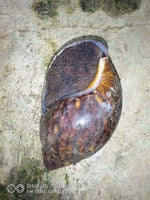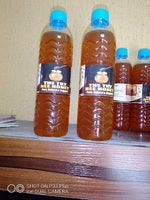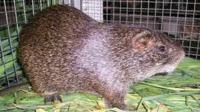Post by Ismail AbdulAzeez on Dec 10, 2017 16:18:37 GMT 1
A Professor of Animal Breeding and Genetics in the 'College of Animal Science and Livestock Production (COLANIM), Federal University of Agriculture, Abeokuta (FUNAAB), Professor Olufunmilayo Adebambo and her poultry-breeding team, have developed a new breed of chicken in the University, called FUNAAB – Alpha, after over 20 years of continuous research.
According to the University Don, she started the project in 1994, with the first generation of chickens, collected randomly all over South West, Nigeria. Recalling her experience, Professor Adebambo noted that the different types of local chickens (Normal Fethered, Frizzle Feathered and Naked Necks), were collected all over Nigeria by students in the Department of Animal Breeding and Genetics (COLANIM) and were screened for conservation and multiplication by her first Ph.D student, late Dr. (Mrs.) Josephine Adenowo, during which, eggs were taken to Oyo town, Oyo State, for hatching.
Explaining further, Professor Adebambo stated that she started the second generation of the birds after screening and selection from 1,000 birds, only 27 got into the cage. This, she said, was done to screen against diseases and upon getting into the cage, the birds were further screened against brooding, because as local chickens, they had the tendency to brood after egg laying, which is usually in clutches, after which the chicks are reared. These activities, therefore, render them unproductive like imported birds. Since motherhood is not allowed for commercial poultry business, only 17 non-broody birds formed the foundation stock in the cage. "From these 17, we started multiplication, cross-breeding, back-crossing and crisscrossing, which brought us to where we are today”. We presently have a Gene Pool of seven lines from which the Alpha lines were generated. The birds are presently on test across the country, by rural farmers, as we are in the process of registering the breeds as FUNAAB-Alpha, the first indigenous chicken for Nigeria and which was developed by Nigerian scientists from the local scavenging chickens, viz: FUNAAB-Alpha indigenous birds (Fin-Alpha Birds). The FIn-Alpha birds comprise FIn-a Pullets and FIn-a broilers, selected over 12 and six generations, respectively. The FIn-aP is the dual purpose chickens, meant for meat and egg production, while the FIn-a B and the broilers are the meat type only.
The Professor of Animal Breeding and Genetics noted that to develop the meat line, two of her postgraduate students had to work critically on the genomics aspect, which could aid selection, using the blood group and genetic polymorphisms, to select for higher body weight in the birds. The result is that with the six generations of selection, the broiler line attains the 1.5 kg weight at eight weeks. Professor Adebambo, who likened birds to human beings, said while human beings have A, B and O blood groups, chickens have A to Z blood groups, as well as the immune response genes used in selection for disease resistance/tolerance. She added that "presently, the chickens are being tested, all over Nigeria on our linkage with the African Chicken Genetic Gain (ACGG), sponsored under the International Livestock Research Institute (ILRI) Ethiopia. The Bill & Melinda Gates' Foundation-sponsored Pearl Project has been linked to the ACGG, which is operating in three countries within Sub- Saharan Africa, namely: Ethiopia, Tanzania and Nigeria. The ACGG is testing five other chicken breeds along with the FUNAAB-Alpha all-over Nigeria, under the Rural Household Economic Empowerment Scheme. This is to enable the farmers to decide on the two most preferred breeds under rural scavenging conditions. With the African Chicken Genetic Gain project, our birds are presently distributed across the five agro-ecological zones of the country. They are being reared by farmers in Rivers, Imo, Kwara, Nasarawa, and Kebbi states by 2,500 rural farmers.
At the last Science and Technology Expo in Abuja, all the birds were showcased and since then, request for FIn-a bird had been pouring in from all over the country. The FUNAAB-Alpha birds are also available in Osun, Lagos, Abuja, Ogun and Oyo states. After the 5th generation of selection, the improved indigenous chickens were initially showcased at the National Universities Commission's Universities Research Fairs in 2004 and 2005, where the research won awards for indigenous chicken development in the country.
Professor Adebambo explained that Sasso chicken was imported from France, Kuroiler chicken from Uganda for the test, along with Shika Brown, the chicken breed developed by the National Animal Production Research Institute (NAPRI), Ahmadu Bello University, Zaria, while the Fulani chickens are from the Obafemi Awolowo University, Ile-Ife. These were being evaluated alongside the FUNAAB Alpha with some of the results generated.
Professor Adebambo noted that results generated from the research indicated that FUNAAB Alpha was almost at par with the imported Sasso and Kuroiler and much better than the Fulani and the Shika brown, according to the result generated by ACGG. The cocks, at 20 weeks of age, had body weight of 1.3kg for Fulani cocks; FUNAAB-Alpha, 2.6; Shika Brown, 1.9; Kuroiler 2.9 and Sasso, 3.0., while for the hens, the body weight was 1.0,1.9,1.6,2.3, and 2.2, respectively. The data also indicated that the age at first lay for Fulani chicken was 18 weeks; FUNAAB Alpha, 17 weeks; Shika Brown, 17 weeks; Kuroiler 18 weeks and Sasso, 19 weeks while the average egg weight per gram was 42, 51, 54, 55, and 55, respectively. Mortality of the FUNAAB-Alpha recorded on our station was less than three per cent at the brooding phase, two per cent at the growing phase and 3.5 per cent at the laying phase.
According to the University Don, she started the project in 1994, with the first generation of chickens, collected randomly all over South West, Nigeria. Recalling her experience, Professor Adebambo noted that the different types of local chickens (Normal Fethered, Frizzle Feathered and Naked Necks), were collected all over Nigeria by students in the Department of Animal Breeding and Genetics (COLANIM) and were screened for conservation and multiplication by her first Ph.D student, late Dr. (Mrs.) Josephine Adenowo, during which, eggs were taken to Oyo town, Oyo State, for hatching.
Explaining further, Professor Adebambo stated that she started the second generation of the birds after screening and selection from 1,000 birds, only 27 got into the cage. This, she said, was done to screen against diseases and upon getting into the cage, the birds were further screened against brooding, because as local chickens, they had the tendency to brood after egg laying, which is usually in clutches, after which the chicks are reared. These activities, therefore, render them unproductive like imported birds. Since motherhood is not allowed for commercial poultry business, only 17 non-broody birds formed the foundation stock in the cage. "From these 17, we started multiplication, cross-breeding, back-crossing and crisscrossing, which brought us to where we are today”. We presently have a Gene Pool of seven lines from which the Alpha lines were generated. The birds are presently on test across the country, by rural farmers, as we are in the process of registering the breeds as FUNAAB-Alpha, the first indigenous chicken for Nigeria and which was developed by Nigerian scientists from the local scavenging chickens, viz: FUNAAB-Alpha indigenous birds (Fin-Alpha Birds). The FIn-Alpha birds comprise FIn-a Pullets and FIn-a broilers, selected over 12 and six generations, respectively. The FIn-aP is the dual purpose chickens, meant for meat and egg production, while the FIn-a B and the broilers are the meat type only.
The Professor of Animal Breeding and Genetics noted that to develop the meat line, two of her postgraduate students had to work critically on the genomics aspect, which could aid selection, using the blood group and genetic polymorphisms, to select for higher body weight in the birds. The result is that with the six generations of selection, the broiler line attains the 1.5 kg weight at eight weeks. Professor Adebambo, who likened birds to human beings, said while human beings have A, B and O blood groups, chickens have A to Z blood groups, as well as the immune response genes used in selection for disease resistance/tolerance. She added that "presently, the chickens are being tested, all over Nigeria on our linkage with the African Chicken Genetic Gain (ACGG), sponsored under the International Livestock Research Institute (ILRI) Ethiopia. The Bill & Melinda Gates' Foundation-sponsored Pearl Project has been linked to the ACGG, which is operating in three countries within Sub- Saharan Africa, namely: Ethiopia, Tanzania and Nigeria. The ACGG is testing five other chicken breeds along with the FUNAAB-Alpha all-over Nigeria, under the Rural Household Economic Empowerment Scheme. This is to enable the farmers to decide on the two most preferred breeds under rural scavenging conditions. With the African Chicken Genetic Gain project, our birds are presently distributed across the five agro-ecological zones of the country. They are being reared by farmers in Rivers, Imo, Kwara, Nasarawa, and Kebbi states by 2,500 rural farmers.
At the last Science and Technology Expo in Abuja, all the birds were showcased and since then, request for FIn-a bird had been pouring in from all over the country. The FUNAAB-Alpha birds are also available in Osun, Lagos, Abuja, Ogun and Oyo states. After the 5th generation of selection, the improved indigenous chickens were initially showcased at the National Universities Commission's Universities Research Fairs in 2004 and 2005, where the research won awards for indigenous chicken development in the country.
Professor Adebambo explained that Sasso chicken was imported from France, Kuroiler chicken from Uganda for the test, along with Shika Brown, the chicken breed developed by the National Animal Production Research Institute (NAPRI), Ahmadu Bello University, Zaria, while the Fulani chickens are from the Obafemi Awolowo University, Ile-Ife. These were being evaluated alongside the FUNAAB Alpha with some of the results generated.
Professor Adebambo noted that results generated from the research indicated that FUNAAB Alpha was almost at par with the imported Sasso and Kuroiler and much better than the Fulani and the Shika brown, according to the result generated by ACGG. The cocks, at 20 weeks of age, had body weight of 1.3kg for Fulani cocks; FUNAAB-Alpha, 2.6; Shika Brown, 1.9; Kuroiler 2.9 and Sasso, 3.0., while for the hens, the body weight was 1.0,1.9,1.6,2.3, and 2.2, respectively. The data also indicated that the age at first lay for Fulani chicken was 18 weeks; FUNAAB Alpha, 17 weeks; Shika Brown, 17 weeks; Kuroiler 18 weeks and Sasso, 19 weeks while the average egg weight per gram was 42, 51, 54, 55, and 55, respectively. Mortality of the FUNAAB-Alpha recorded on our station was less than three per cent at the brooding phase, two per cent at the growing phase and 3.5 per cent at the laying phase.












